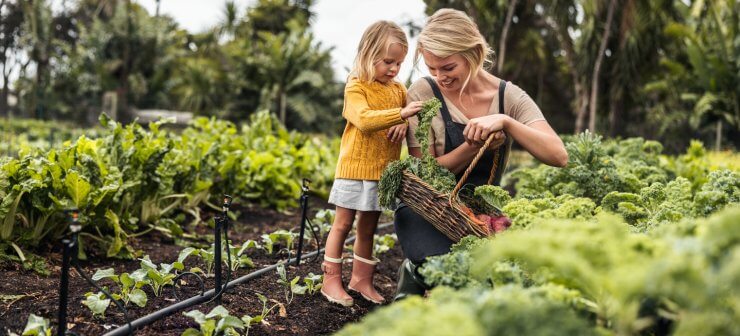
Woman and child harvesting fresh kale
How you harvest your kale depends on a combination of the type of kale you’re growing, and when you want it—a little at a time, or all at once? Kale is among the group of crops we call “cut-and-come-again.” You can harvest just the older, outer leaves as you need them, or wait until the kale plant is fully grown and then harvest the whole plant.
If you’re going to use the “cut-and-come-again” approach, you can start harvesting kale leaves when your plants have 10 to 12 leaves. Ideally, you have a row of kale growing, so you only need to take a couple leaves from each plant at a time. Cut the leaves off at the base of the plant. Always harvest from the outside in. The older leaves are on the outside, and the energy-producing leaves are at the top, in the center.
If you planted a spring crop, it’s probably a good idea to harvest the whole plant as soon as it’s reached maturity—even if you’ve been harvesting a few leaves at a time—in case the weather turns hot. In the fall, you can pick an ongoing harvest of leaves to have a steady supply. If the plants are still young, watch out for cold snaps. While kale loves cold weather, and will even tolerate frost, young plants need protection. Always have a frost blanket on hand, just in case.
The great thing about a fall crop of kale is when the plants are mature and the weather gets cold. Some kale varieties actually taste better after the temperature drops. In some regions, kale will survive over the winter and produce tender leaves in the spring. But once you harvest this bonus crop you’ll want to plant fresh seeds.
We tend to treat kale like an annual, but it’s actually a biennial. In the first year of its life cycle, it puts its energy into producing leaves. In the second year, the plant works on flowering and producing seeds. If you’ve ever harvested a crop after it’s gone to seed, you probably noticed a bitter flavor. That’s because the plant was putting all its energy into producing seeds. So, in the case of kale, all those luscious leaves were just fuel for producing seeds. And hardworking leaves like that are not tasty.
However, if you are growing an heirloom crop and you want to save the seeds, let the plant overwinter and you’ll have a new kind of harvest to look forward to.
When you do harvest, it’s best to use garden shears to cut the leaves from the plant. More than one gardener has completely uprooted their kale by trying to just snap the leaves off.
If you’re going to harvest the whole head of kale at once, use garden shears or a sharp garden knife to cut the kale off at the soil line, separating it from the roots.
Store freshly picked kale in the fridge, in the crisper drawer, for up to a week. Wash it just before you use it.


 Previous
Previous

